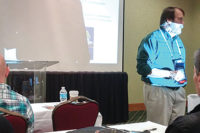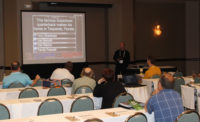“We can’t keep doing the same things and expect to fill the [technician] gap. It’s not going to happen. We need to be willing to try new things.” These words, from Dr. Kitty Manley, a graduate professor in Ferris State University’s (FSU’s) College of Education and Human Services, opened up the 2016 HVACR Instructor’s Workshop Aug. 1-3 at FSU in Big Rapids, Michigan.
This workshop took the unique approach of gathering HVAC educators and presenters from all across the country and allowing them to share thoughts, opinions, ideas, and lessons to help shape the future of the industry.
There is trepidation throughout the HVAC industry about the best way forward and how to properly bring in and train the next generation. How can the skills gap be addressed? What is the best way to reach out to students who are interested in the skilled trades? How can educators ensure they are providing the best possible learning environment for their students once they get them inside the classroom?
These pertinent questions and many more were among those presented at the conference, and while every problem wasn’t solved, solutions were presented and educators took notice.
AN HVACR VISION
Manley’s keynote speech at the conference detailed what she called a new vision for HVACR education. She focused on multiple topics, including rewarding innovation, treating each student as an individual, and ensuring there are multiple pathways for students to succeed in the classroom.
“One of the things I hear in corporate America is, ‘They have a degree from so-and-so university, but they get here and don’t know what they are doing.’ We must develop corrective activities when students fail,” she said. “We must recognize it won’t take all students the same amount of time to learn the same number of competencies. It’s ludicrous. We must figure this out. These students often drop out and don’t come back to our industry.”
Manley grades students on what she calls an A, B, or not-yet scale.
“Always keep working on things,” she said. “Don’t fail students, but rather help them succeed. It’s part of thinking differently.”
Doug Zentz, associate professor and HVAC department coordinator, FSU, said students are unprepared both academically and socially, which makes it harder to retain and graduate students. In fact, he referenced this as the most pressing challenge HVAC instructors encounter every semester.
However, instructors and educators must also be willing to broaden their horizons and continue to learn new tricks of the trade if they are going to ensure a successful future, he said, adding professional development is critical for instructors, as well.
“While one-third of instructors participated in professional development programs three or more times a year, more than 50 percent haven’t participated in any professional development at all to refresh their knowledge and skills,” he said.
BRANCHING OFF
While the technician gap took center stage, presentations spanned a variety of topics.
Donald Prather, technical services manager, ACCA, presented on the contractor association’s educational offerings and training materials. He focused on new lesson plans and course offerings that have been developed recently to make students work smarter and more efficiently.
Tom Jackson, CEO of Jackson Systems LLC, led a session examining different methods for maintaining proper static pressure and temperature control in forced-air zoned systems.
Other sessions highlighted the latest trends in hydronic heating and cooling, variable refrigerant flow (VRF) heat recovery, how to prevent compressor failures, and alternative refrigerant challenges in a low-GWP (global warming potential) world.
TECHNOLOGY IN THE CLASSROOM
Craig Sekowski, learning consultant for Cengage Learning, also presented on technology’s role in the HVAC classroom and how it is constantly evolving and changing.
Earlier in the conference, Zentz had said that around 90 percent of online students at FSU are working adults. Completing work online is obviously a growing part of many educational models, including those in HVAC.
“There are some important ways to facilitate technology in and out of the classroom,” he said. “Technology in the field varies greatly, as some is simple and some is very complex, but it is important to note that communication devices are evolving and advancing. Consumer HVAC technology is evolving, as well. Smart homes continue to grow, and smart thermostats are at the forefront of that growth. Students must be prepared.”
Sekowski noted that 46 percent of students are more likely to read an assignment in a digital format, and 38 percent of students say they can’t go more than 10 minutes without checking a digital device.
“Students are increasingly attached to digital devices, and using digital simulations provides your students with a great opportunity to learn without having any of the risk,” he said.
Sekowski also said 65 percent of students overall are visual learners, 30 percent are auditory learners, and 5 percent learn best by doing things hands-on. HVAC students often fall into the hands-on category.
“The HVAC industry must be willing to say, ‘We have a serious issue, and we need to do something different,’” said Manley.
This workshop, and others like it around the country, is a great step toward ensuring that happens.
Publication date: 9/26/2016
Want more HVAC industry news and information? Join The NEWS on Facebook, Twitter, and LinkedIn today!






